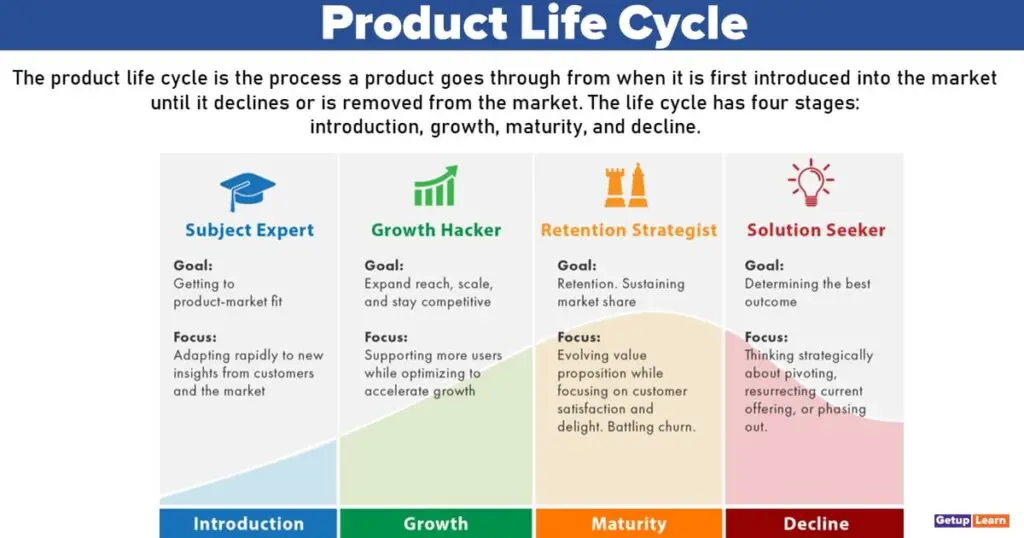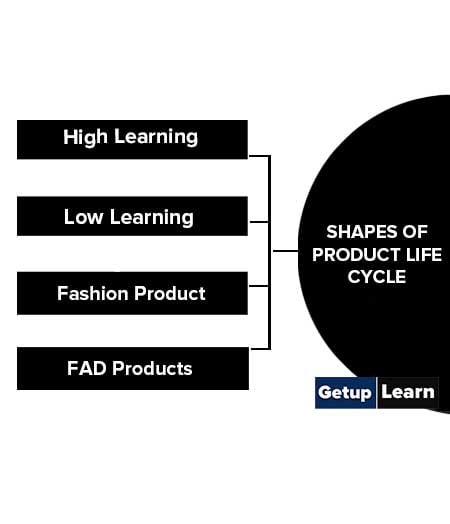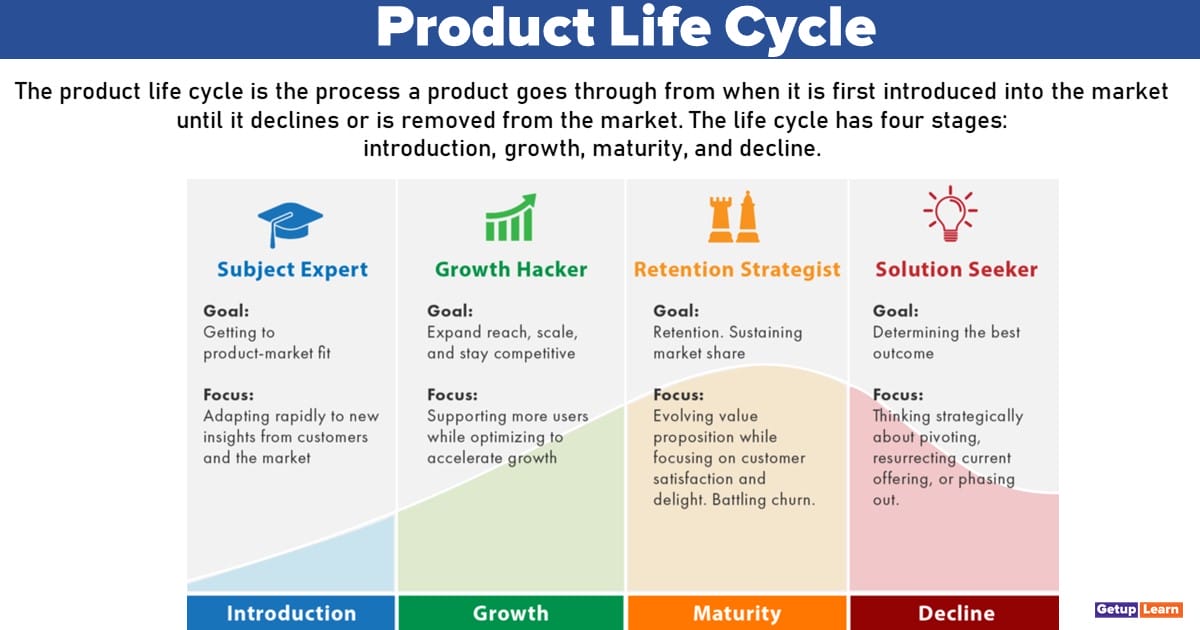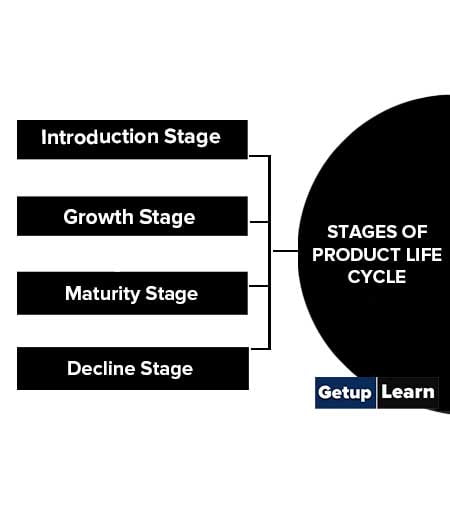Table of Contents
What is Product Life Cycle?
The product life cycle is the process a product goes through from when it is first introduced into the market until it declines or is removed from the market. The life cycle has four stages: introduction, growth, maturity, and decline.
In other words, The product life cycle is an important concept in marketing. It describes the stages a product goes through from when it was first thought of until it finally is removed from the market. Not all products reach this final stage. Some continue to grow and others rise and fall.

While some products may stay in a prolonged maturity state, all products eventually phase out of the market due to several factors including saturation, increased competition, decreased demand, and dropping sales.
Additionally, companies use PLC analysis (examining their product’s life cycle) to create strategies to sustain their product’s longevity or change it to meet market demand or develop technologies. Generally, there are four stages to the product life cycle, from the product’s development to its decline in value and eventual retirement from the market.
The product life cycle has 4 very clearly defined stages, each with its own characteristics that mean different things for businesses that are trying to manage the life cycle of their particular products.
Stages of Product Life Cycle
The theory of a product life cycle was first introduced in the 1950s to explain the expected life cycle of a typical product from design to obsolescence, a period divided into the phases of product introduction, product growth, maturity, and decline.
The goal of managing a product’s life cycle is to maximize its value and profitability at each stage. The life cycle is primarily associated with marketing theory.
As consumers, we buy millions of products every year. And just like us, these products have a life cycle. Older, long-established products eventually become less popular, while in contrast, the demand for new, more modern goods usually increases quite rapidly after they are launched.
Because most companies understand the different product life cycle stages, and that the products they sell all have a limited lifespan, the majority of them will invest heavily in new product development in order to make sure that their businesses continue to grow.
The product life cycle has 4 very clearly defined stages, each with its own characteristics that mean different things for businesses that are trying to manage the life cycle of their particular products. Following are the 4 stages of product life cycle:
Introduction Stage
Research or engineering skill leads to new product development. The product is put on the market at the stage of commercialization. The concept of the product life cycle starts from the ‘commercialization’ stage of new product development.
At this stage, product awareness and acceptance among prospective customers are minimal. As the sales are low, there are high promotional costs. This is due to the fact that the company has to spend money on advertising, sales promotion, and other forms of promotion.
The major obstacle to rapid market penetration at this stage is poor distribution strategy. Many retailers will not support a new product launch and will wait till they hear well about the brand.
For example, Holographic projection technology allows consumers to turn any flat surface into a touchscreen interface. With a huge investment in research and development and high prices that will only appeal to early adopters, this is another good example of the first stage of the cycle.
Growth Stage
This stage begins when demand grows rapidly. In the case of repeat buying situations, the innovators move from trial purchase to adoption stage If the innovators are satisfied with the products, they influence other buyers through word–of–mouth and referral communication.
Deeper penetration in the market by intensive distribution strategy and increased in-store visibility and usage tend to bring new buyers into the market. The competitors also start their advertising and sales promotion making the total category demand increase in the market. The growth stage also contributes to increasing profit.
For example, With advanced technology delivering the very best viewing experience, Blue Ray equipment is currently enjoying the steady increase in sales that’s typical of the Growth Stage. Organic food is another product that is gaining momentum in the market and is in the growth stage and it has not gained deeper penetration in the marketplace yet.
Maturity Stage
Sales growth continues, but at a diminishing rate, because of the declining number of potential customers who remain unaware of the product or who have taken no action.
For example, Introduced a while back, manufacturers of DVDs and equipment had established a strong market share. However, they still had to deal with the challenges of other technologies. That is characteristic of the Maturity Stage.
Decline Stage
Eventually, sales start declining due to multiple reasons. Changes in customer preferences, competition in the market, technology, and other environmental forces lead to a decline in sales. Sales begin to diminish as the customers begin to get bored with the product.
For example, dial telephones and petrol jeeps led to the eventual dropping of the product by the firms. The product decline happens due to the entry of new competitors with advanced technology; and a reduction in consumer interest. The marketer is left with an option of price reduction, putting pressure on the profit margins and leading to the deletion of products.
For example, Typewriters, and even electronic word processors, have very limited functionality. With consumers demanding a lot more from the electronic equipment they buy, the typewriter is passing through the final stage of the product life cycle.
Product Life Cycle Examples
It’s possible to provide examples of various products to illustrate the different stages of the product life cycle more clearly. Here is the example of watching recorded television and the various stages of each method:
- Introduction = 3D TVs
- Growth = Blueray discs/DVR
- Maturity = DVD
- Decline = Videocassette
The idea of the product life cycle has been around for some time, and it is an important principle manufacturers need to understand in order to make a profit and stay in business.
However, the key to successful manufacturing does not just understand this life cycle, but also proactively manage products throughout their lifetime, applying the appropriate resources and sales and marketing strategies, depending on what stage products are at in the cycle.
Shapes of Product Life Cycle
Products go through different life cycle patterns. There are several shapes that can be observed in practice. The shapes commonly reported are classical bell-shaped curve, growth–slump–maturity pattern, cycle– recycle pattern, scalloped pattern; style, fashion, and fad.
Growth–slump maturity pattern, exhibits an initial growth for the product, followed by a decline in sales and subsequent stability for a fairly long time. Growth–slump–maturity pattern displays a multi-modal shape due to the different promotional mechanisms adopted by marketers at different points in time.
Each curve tends to have its own marketing strategy. There are actually four different life cycle curves for the four different types of products:

High Learning
Product is one that requires significant customer education and the introduction stage is extended. You could say that the GPS was a high–learning product. This is because when the GPS first came out, most people were used to either relying on maps or the directions of others.
When the GPS first came out, many people were not sure how to exactly use it. Now, most people always have GPS with them because they come standard in almost every smartphone and new car.
Low Learning
Products are different because their sales begin very quickly due to the simplicity of the product. This allows consumers to understand the product almost right away. Often competitors can easily copy the low–learning products. This forces companies to broaden their distribution channels quickly.
Fashion Product
These products change with the style of the times and the life cycles frequently appear in apparel. They usually go from the introduction stage right to the decline and then eventually reappear. This does not mean that each fashion product has the same life cycle.
FAD Products
These fad products experience rapid sales during the introduction phase and then they decline at almost the same speed. These products tend to be novelties with a short life cycle.
Assumptions of Product Life Cycle
Following are the assumptions of product life cycle:
- The roots of a product do not remain fixed forever. There is no certainty whether it will die a natural or an unnatural death. It is not certain that a product that has been launched in the market will be there to face all the stages of its life cycle. It may collapse somewhere before the decline stage.
- It may also happen that a product faces two or more stages at a time or there is a merger of stages. In such a case different specific stages have no meaning for the product.
- A product that works in different markets at a time may face different stages therein. For example, in one market it may be passing through a maturity stage whereas in another it has already vanished.
- It is not necessary for the product to have the same period of existence in every stage. The period may vary from stage to stage depending upon how it is fairing in the market.
Product Life Cycle Theory Problems
While the product life cycle theory is widely accepted, it does have critics who say that the theory has so many exceptions and so few rules that it is meaningless. Following are the product life cycle theory problems:
- There is no set amount of time that a product must stay in any stage; each product is different and moves through the stages at different times. Also, the four stages are not the same time period in length, which is often overlooked.
- There is no real proof that all products must die. Some products have been seen to go from maturity back to a period of rapid growth thanks to some improvement or redesign. Some argue that by saying in advance that a product must reach the end of life stage.
It becomes a self-fulfilling prophecy that companies subscribe to. Critics say that some businesses interpret the first downturn in sales to mean that a product has reached decline and should be killed, thus terminating some still- viable products prematurely. - The theory can lead to an over-emphasis on new product releases at the expense of mature products, when in fact the greater profits could possibly be derived from the mature product if a little work was done on revamping the product.
- The theory emphasizes individual products instead of taking larger brands into account.
- The theory does not adequately account for product redesign and/or reinvention.
Characteristics of Product Life Cycle Stages
Now we will understand the characteristics of product life cycle at different stages:
- Characteristics of Introduction Stage
- Characteristics of Growth Stage
- Characteristics of Maturity Stage
- Characteristics of Decline Stage
Characteristics of Introduction Stage
The product life cycle begins with the introduction stage when the product is launched. At this stage:
- Sales are low. This stage involves high distribution and promotion expenses; profits are found to be negative or low. Since it is too early for improvements, basic versions of the product are sold.
- The second possible alternative strategy is low price and promotion. This will help in cornering a bigger market share and faster market penetration. This strategy is possible when the size of the market is big and buyers are sensitive to price.
- The marketer passes the economy of scale of operation to customer and follows a low cost per unit production process.
- At this stage, since the product is new, all focus is on building distribution network and product awareness.
Characteristics of Growth Stage
- This stage is most rewarding for the marketer, if the new product is considered to be satisfactory by the market. The characteristics of this stage include a very sensitive market response where sales climb rapidly.
- The growth stage has two distinct sub–stages – early and late growth. In the early growth stage, the sales increase at an increased rate and in the late growth stage it increases at a decreasing rate.
- At the growth stage, the marketer follows different kinds strategies compared to the earlier stage of product life cycle.
- Increased emphasis on promotions will play a very important role in educating the market as well as in meeting the challenges of the competition.
Characteristics of Maturity Stage
At the end of a responsive growth stage, begins a stage of maturity:
- In this stage despite higher spending on the marketing program there is no substantial growth in sales volume and the market is flooded with many competing products.
- In this stage, though the sales growth slows down, the stage itself continues for a long period. Therefore, it poses a strong challenge to Marketing Managers.
- The market experiences commoditization and competition brings down the prices, putting pressure on the profitability and liquidity of the firm. In the late maturity stage, the profits drop sharply. Due to intense competition and falling profits, not many companies can survive this stage. Thus, a number of proactive steps are needed to stay profitable.
- A market modification strategy, the companies have goals to increase the consumption; hence the companies look for new users, new market.
- The other alternative strategy is to bring product modifications like improvement in quality, features and style.
Characteristics of Decline Stage
Following are the characteristics of decline stage:
- There is a saying that “nothing lasts forever” or “all good things must come to an end”. This is also applicable to successful products and services in the market.
- The sale of any product eventually dips. The plunge continues for some years. This indicates the stage of decline.
- This is the stage when the product is left with very few customers and these customers are called laggards. This is a stage when many of the existing customers switch to newer and better brands in the market.
- The firm reaches this stage due to lack of strategies. A company may have a number of products introduced simultaneously where the extent of decline may not be the same for all the products.
- The company can decide to follow a strategy to maintain its position in the market in territories where it is doing well.
- Alternatively, the company can decide to harvest the market. This strategy is aimed at reducing the overall costs including production, maintenance, advertising and sales force management costs and hoping that the product sales will be profitable for some time more.
- Eventually the firm will decide to drop the product from its portfolio. This is the end of the line for a particular product. However, it may be sold to another company if there is a buyer.
What is the life cycle of a product called?
The product life cycle is the process a product goes through from when it is first introduced into the market until it declines or is removed from the market. The life cycle has four stages: introduction, growth, maturity and decline.
What are the stages of product life cycle?
Stages of product life cycle are:
1. Introduction Stage
2. Growth Stage
3. Maturity Stage
4. Decline Stage.
What are the shapes of product life cycle?
Shapes of product life cycle are:
1. High Learning
2. Low Learning
3. Fashion Product
4. FAD Products.


